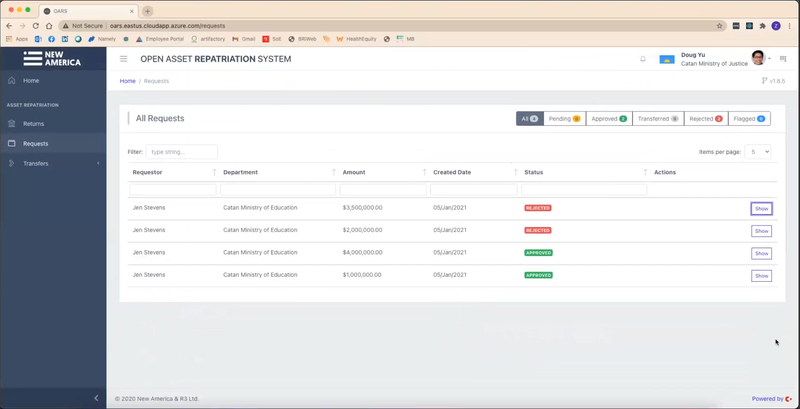Reducing Waste and Corruption Through Public Asset Accountability
Project Capsule: Open Asset Repatriation System
Blog Post

Dec. 15, 2020
PROJECT CAPSULE
Open Asset Repatriation System (OARS) increases the transparency and accountability of assets returned by the United States to a recipient country. Using distributed ledger technology (DLT), OARS creates immutable records of asset transactions and authorizers, offering the U.S. Government, the government of the receiving country, and civil society organizations visibility into the status and of funds transferred during the return process.
PROJECT STATUS
Clickable prototype developed. Awaiting the identification of a recipient country for pilot testing.
CHALLENGE OARS ADDRESSES
Billions of dollars are plundered and stolen each year by kleptocrats and dictators. Efforts to recuperate ill-gotten funds transcend borders and financial centers, and ultimately require vast legal and investigative resources over numerous years by governments fighting corruption. Upon completing the cumbersome asset recovery legal process, the countries recovering the assets are faced with the challenge of how to best return the recuperated assets in a manner that ensures the assets will not be lost once again to corruption or fraud.
KEY FEATURES
- OARS securely tracks and records requests by authorized agencies in the receiving country seeking to utilize returned assets.
- Assets are returned to a recipient country off-ledger, but a record of that transaction is recorded in OARS. OARS tracks all actions on the Corda distributed ledger. The system provides simple audit capabilities for specific returned funds. A permanent, cryptographically-signed record is created (“hash”).
- OARS manages workflow amongst several participants working on an asset return process. Roles and actions reflect good governance best practices to fight corruption and limit loss traceability. Unique user IDs track allocation action and requests provenance. For example, the system provides visibility into a treasury department official approving a fund transfer or an approved recipient government agency worker managing assets for a specific purpose.
- An administrator configures the user roles and login credentials based on the terms of the asset return set forth by mutual agreement.
- There are safeguards for the privacy of government authorizers and users while offering asset disposition transparency to civil society organizations.
BROADER IMPACT
OARS could be repurposed to track asset movement between government departments or between regional and national government networks. Given adequate political will and compatible integration with banking systems, OARS can not only trace asset movement but could eventually be harnessed to transfer tokenized assets, providing complete real-time transparency and accountability in the movement of funds, and potentially providing multiple on-ledger authorization points that go beyond providing transparency and accountability to actually preventing theft.
COLLABORATION
This project is administered through a federal grant awarded by the U.S. Department of State, Bureau of International Narcotics and Law (INL). New America is working with the U.S. Department of State, U.S. Department of Justice, and R3 on the solution.
NEXT STEPS
Receive pilot country selection from the U.S. Department of Justice and build a solution tailored for a specific asset return to that country.
SOLUTION LINK | OPEN SOURCE CODE REPOSITORY